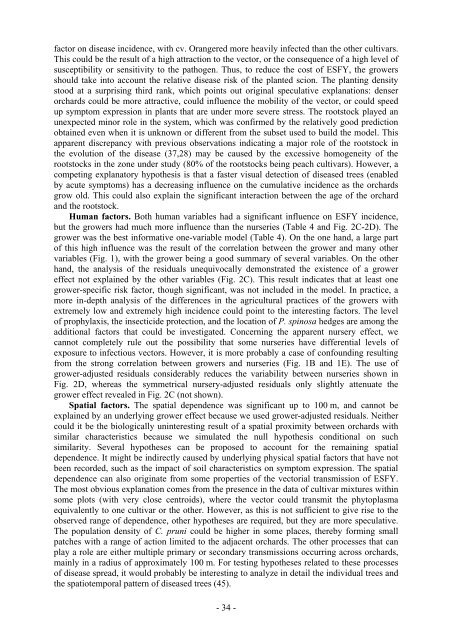Ecole Nationale Supérieure Agronomique de Montpellier ... - CIAM
Ecole Nationale Supérieure Agronomique de Montpellier ... - CIAM
Ecole Nationale Supérieure Agronomique de Montpellier ... - CIAM
Create successful ePaper yourself
Turn your PDF publications into a flip-book with our unique Google optimized e-Paper software.
factor on disease inci<strong>de</strong>nce, with cv. Orangered more heavily infected than the other cultivars.<br />
This could be the result of a high attraction to the vector, or the consequence of a high level of<br />
susceptibility or sensitivity to the pathogen. Thus, to reduce the cost of ESFY, the growers<br />
should take into account the relative disease risk of the planted scion. The planting <strong>de</strong>nsity<br />
stood at a surprising third rank, which points out original speculative explanations: <strong>de</strong>nser<br />
orchards could be more attractive, could influence the mobility of the vector, or could speed<br />
up symptom expression in plants that are un<strong>de</strong>r more severe stress. The rootstock played an<br />
unexpected minor role in the system, which was confirmed by the relatively good prediction<br />
obtained even when it is unknown or different from the subset used to build the mo<strong>de</strong>l. This<br />
apparent discrepancy with previous observations indicating a major role of the rootstock in<br />
the evolution of the disease (37,28) may be caused by the excessive homogeneity of the<br />
rootstocks in the zone un<strong>de</strong>r study (80% of the rootstocks being peach cultivars). However, a<br />
competing explanatory hypothesis is that a faster visual <strong>de</strong>tection of diseased trees (enabled<br />
by acute symptoms) has a <strong>de</strong>creasing influence on the cumulative inci<strong>de</strong>nce as the orchards<br />
grow old. This could also explain the significant interaction between the age of the orchard<br />
and the rootstock.<br />
Human factors. Both human variables had a significant influence on ESFY inci<strong>de</strong>nce,<br />
but the growers had much more influence than the nurseries (Table 4 and Fig. 2C-2D). The<br />
grower was the best informative one-variable mo<strong>de</strong>l (Table 4). On the one hand, a large part<br />
of this high influence was the result of the correlation between the grower and many other<br />
variables (Fig. 1), with the grower being a good summary of several variables. On the other<br />
hand, the analysis of the residuals unequivocally <strong>de</strong>monstrated the existence of a grower<br />
effect not explained by the other variables (Fig. 2C). This result indicates that at least one<br />
grower-specific risk factor, though significant, was not inclu<strong>de</strong>d in the mo<strong>de</strong>l. In practice, a<br />
more in-<strong>de</strong>pth analysis of the differences in the agricultural practices of the growers with<br />
extremely low and extremely high inci<strong>de</strong>nce could point to the interesting factors. The level<br />
of prophylaxis, the insectici<strong>de</strong> protection, and the location of P. spinosa hedges are among the<br />
additional factors that could be investigated. Concerning the apparent nursery effect, we<br />
cannot completely rule out the possibility that some nurseries have differential levels of<br />
exposure to infectious vectors. However, it is more probably a case of confounding resulting<br />
from the strong correlation between growers and nurseries (Fig. 1B and 1E). The use of<br />
grower-adjusted residuals consi<strong>de</strong>rably reduces the variability between nurseries shown in<br />
Fig. 2D, whereas the symmetrical nursery-adjusted residuals only slightly attenuate the<br />
grower effect revealed in Fig. 2C (not shown).<br />
Spatial factors. The spatial <strong>de</strong>pen<strong>de</strong>nce was significant up to 100 m, and cannot be<br />
explained by an un<strong>de</strong>rlying grower effect because we used grower-adjusted residuals. Neither<br />
could it be the biologically uninteresting result of a spatial proximity between orchards with<br />
similar characteristics because we simulated the null hypothesis conditional on such<br />
similarity. Several hypotheses can be proposed to account for the remaining spatial<br />
<strong>de</strong>pen<strong>de</strong>nce. It might be indirectly caused by un<strong>de</strong>rlying physical spatial factors that have not<br />
been recor<strong>de</strong>d, such as the impact of soil characteristics on symptom expression. The spatial<br />
<strong>de</strong>pen<strong>de</strong>nce can also originate from some properties of the vectorial transmission of ESFY.<br />
The most obvious explanation comes from the presence in the data of cultivar mixtures within<br />
some plots (with very close centroids), where the vector could transmit the phytoplasma<br />
equivalently to one cultivar or the other. However, as this is not sufficient to give rise to the<br />
observed range of <strong>de</strong>pen<strong>de</strong>nce, other hypotheses are required, but they are more speculative.<br />
The population <strong>de</strong>nsity of C. pruni could be higher in some places, thereby forming small<br />
patches with a range of action limited to the adjacent orchards. The other processes that can<br />
play a role are either multiple primary or secondary transmissions occurring across orchards,<br />
mainly in a radius of approximately 100 m. For testing hypotheses related to these processes<br />
of disease spread, it would probably be interesting to analyze in <strong>de</strong>tail the individual trees and<br />
the spatiotemporal pattern of diseased trees (45).<br />
- 34 -



